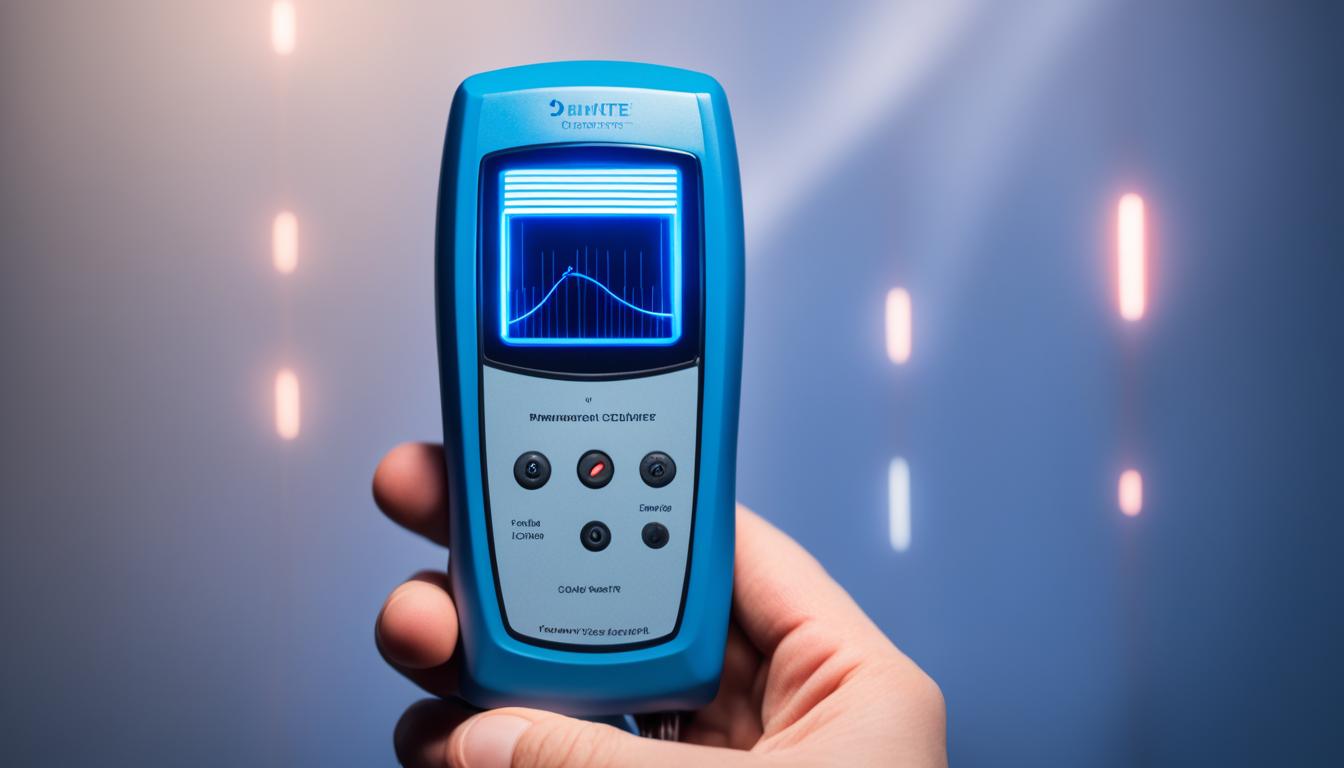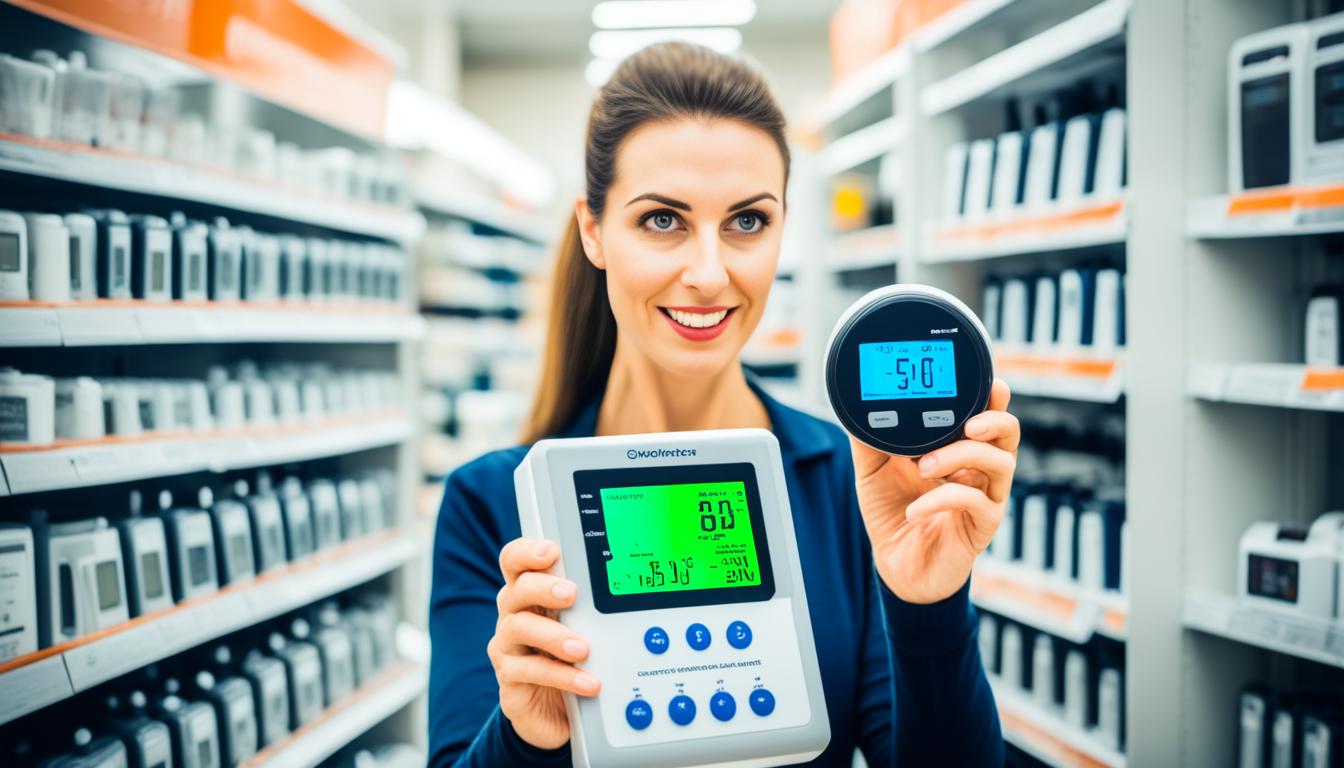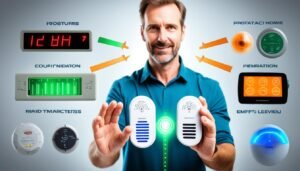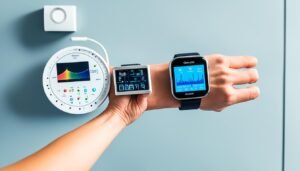Disclosure: This Post Contains Affiliate Links; We earn a commission on purchases.
An EMF meter is a specialized device used to measure electromagnetic fields. In today’s wireless world, where we are surrounded by various forms of technology, it’s crucial to be aware of the potential risks associated with electromagnetic fields (EMFs). The right EMF meter can help you monitor and assess the EMF levels in your environment, allowing you to make informed decisions to protect yourself and your loved ones.
When it comes to choosing an EMF meter, there are several factors to consider to ensure you make the right decision. Let’s take a look at some essential factors to keep in mind.
Key Takeaways:
- Choose an EMF meter that can detect the specific types of EMFs you are concerned about, such as magnetic fields, electric fields, or radio frequencies.
- Consider the frequency range of the EMF meter to ensure it covers the range of EMFs you want to measure.
- Accuracy and sensitivity are vital factors. Look for an EMF meter that provides precise and reliable readings.
- Check the data display options of the EMF meter. Some meters offer simple color codes, while others provide detailed numerical readings.
- Always opt for reputable brands that offer warranty and service support for your peace of mind.
What are EMFs and Their Health Risks?
EMFs, or electromagnetic fields, are electric, magnetic, and electromagnetic waves that are produced by electrical devices, power lines, and wireless networks. These fields surround us in our daily lives, and while they are invisible, they can potentially have harmful effects on human health. It is important to understand the health risks associated with EMFs and take steps to minimize exposure.
Research on the health risks of EMFs is still ongoing, but there is evidence to suggest a possible link between non-ionized EMF exposure and adverse health effects. Some studies have shown that long-term exposure to high levels of EMFs can have a range of negative impacts on our well-being. These effects can include neurological disorders, psychological disturbances, cognitive impairments, and disruptions to the nervous system.
“Research has found a possible link between non-ionized EMF exposure and adverse health effects.”
While the exact mechanisms by which EMFs affect our health are not fully understood, it is believed that these fields can interfere with the body’s natural electrical processes, leading to physiological changes. Additionally, some studies have suggested that constant exposure to EMFs may disrupt the production of melatonin, a hormone that regulates sleep patterns and plays a crucial role in maintaining overall health.
Minimizing Exposure to EMFs
Considering the potential risks associated with EMFs, it is crucial to take steps to minimize exposure, especially in areas where EMF exposure is high, such as near power lines or in locations with dense wireless networks.
- Avoid prolonged exposure to high EMF sources, such as keeping a safe distance from power lines, transformers, and electrical substations.
- Limit the use of wireless devices, such as cell phones, and use hands-free options whenever possible to reduce direct exposure to the head and body.
- Keep electronic devices and wireless routers away from sleeping areas to minimize exposure during rest.
- Consider using shielding materials, such as special paints or fabrics, which can help reduce the penetration of EMFs into living spaces.
- When purchasing electrical appliances, opt for those with lower EMF emissions and ensure they meet safety regulations.
By implementing these preventative measures, individuals can lower their overall exposure to EMFs and potentially reduce the associated health risks.
It is worth noting that while the research on EMFs and their health effects is still evolving, it is always prudent to exercise caution and stay informed about the latest findings. Monitoring EMF levels in our surroundings and taking steps to minimize exposure can contribute to maintaining a healthy environment for ourselves and our loved ones.
Types of EMFs and Measurement Frequencies
When it comes to electromagnetic fields (EMFs), understanding the different types and measurement frequencies is crucial. By knowing the types of EMFs and their frequencies, you can make an informed decision when choosing an EMF meter for detection and measurement.
There are two main types of EMFs: non-ionizing and ionizing. Non-ionizing EMFs have low to mid-frequencies and are commonly emitted by power lines, cell phones, WiFi networks, and household appliances. On the other hand, ionizing EMFs have higher frequencies and are less prevalent, typically associated with sources such as X-rays and gamma rays.
When selecting an EMF meter, it’s important to consider its detection capabilities and frequency range. Some meters are specifically designed to detect certain types of EMFs, while others can measure multiple types simultaneously. Therefore, it’s essential to choose a meter that aligns with the types of EMFs you want to measure in your environment.
If you are interested in measuring non-ionizing EMFs emitted by everyday devices and appliances, a meter with a low to mid-frequency range is suitable. However, if you have specific concerns about ionizing EMFs, such as X-ray exposure, it’s important to choose a meter with a higher frequency range.
Here is a breakdown of the different types of EMFs and their measurement frequencies:
- Non-ionizing EMFs
- Power lines: 50-60 Hz
- Cell phones: 900 MHz – 2.4 GHz
- WiFi networks: 2.4 GHz – 5 GHz
- Household appliances: Varies depending on the device
- Ionizing EMFs
- X-rays: 30 petahertz – 30 exahertz
- Gamma rays: Greater than 30 exahertz
By understanding the types of EMFs and their corresponding measurement frequencies, you can choose an EMF meter that aligns with your specific needs and concerns. Whether you’re monitoring the EMF levels in your home or workplace, having the right meter will enable you to take proactive steps towards reducing your exposure and creating a healthier environment.
Features and Functionality of EMF Meters
EMF meters come with various features and functionalities that make them versatile tools for measuring electromagnetic fields. When choosing an EMF meter, it’s important to consider the specific features that meet your needs and preferences.
Detection Capabilities
One of the essential features to consider in an EMF meter is its detection capabilities. Some meters are designed to detect specific types of EMFs, such as radio frequencies (RF), magnetic fields, electric fields, or a combination of these. Understanding the types of EMFs you want to measure will help you select the most suitable meter.
Accuracy and Sensitivity
The accuracy and sensitivity of an EMF meter are crucial for obtaining reliable and precise measurements. Look for meters that have been calibrated and tested for accuracy. Higher sensitivity allows the meter to detect even low levels of EMFs, providing a more detailed picture of the electromagnetic environment.
Data Display Options
EMF meters offer different data display options to present measurement results. Some meters provide simple color codes or LED indicators that represent the general levels of EMF exposure. Others offer more advanced data displays with detailed numerical readings, allowing you to analyze the specific strengths and frequencies of EMFs in your environment.
“Effective EMF measurements require accuracy, sensitivity, and clear data display options.”
Choosing a meter with a data display that suits your preferences and level of expertise will enhance your ability to interpret and assess EMF readings effectively.
A Comparison of EMF Meter Features
| EMF Meter Model | Detection Capabilities | Accuracy | Sensitivity | Data Display |
|---|---|---|---|---|
| Safe and Sound Pro II RF Meter | RF, magnetic fields, electric fields | High | High | Numerical readings |
| Safe and Sound Classic II | Magnetic fields, electric fields | Medium | Medium | Color codes |
| TriField EMF Meter Model TF2 | RF, magnetic fields, electric fields | High | High | Numerical readings |
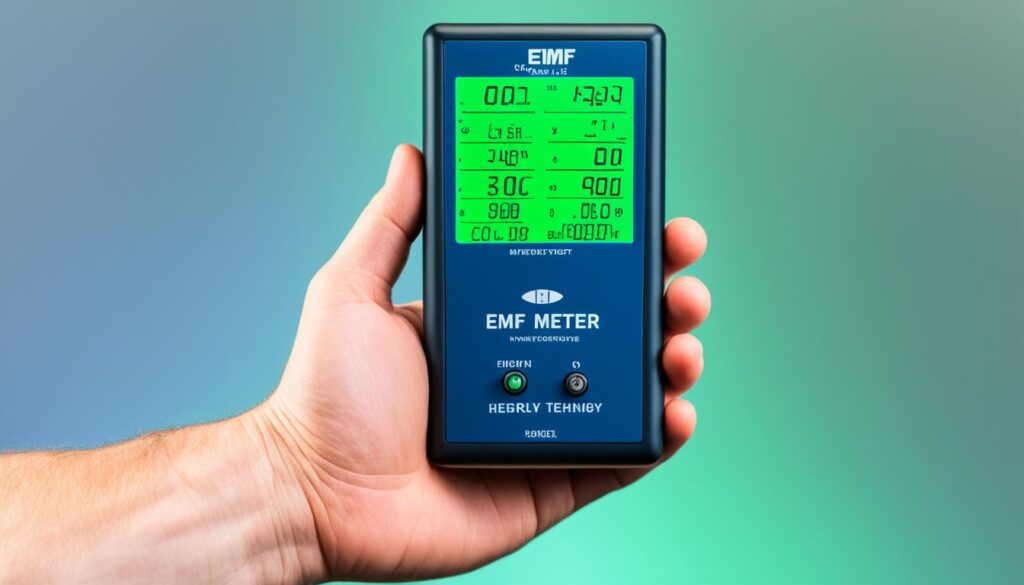
The table above presents a comparison of different EMF meter models, highlighting their detection capabilities, accuracy, sensitivity, and data display options. It provides a helpful overview to aid in your decision-making process.
Ultimately, the features and functionality of an EMF meter contribute to its effectiveness in assessing and managing EMF exposure. By considering the detection capabilities, accuracy, sensitivity, and data display options, you can select an EMF meter that meets your specific requirements and empowers you to protect yourself and your loved ones from potential EMF-related risks.
Comparison of EMF Meter Models
When comparing different EMF meter models, there are several options to consider. Each model offers unique features and capabilities for measuring electromagnetic fields. Let’s take a closer look at some popular EMF meter models:
Safe and Sound Pro II RF Meter
The Safe and Sound Pro II RF Meter is an excellent choice for advanced RF measurements. It provides detailed data and analysis of radio frequencies, allowing you to assess exposure levels accurately. This meter is ideal for professionals or individuals who require in-depth RF measurements.
Safe and Sound Classic II
The Safe and Sound Classic II is a more affordable option that offers reliable measurements of RF radiation. It is suitable for general home use, allowing you to monitor wireless devices and power lines. This meter provides essential information to help you make informed decisions about EMF exposure.
TriField EMF Meter Model TF2
The TriField EMF Meter Model TF2 is a versatile meter that can measure multiple types of EMFs. It is suitable for various applications, including measuring electric fields, magnetic fields, and radio frequencies. This meter offers a comprehensive solution for assessing different sources of EMF radiation.
Safe and Sound Micro RF Detector
The Safe and Sound Micro RF Detector is a highly sensitive wristband detector that monitors RF exposure. It alerts users if exposure levels exceed set limits, allowing for immediate action to minimize exposure. This portable and convenient detector is ideal for individuals concerned about RF radiation from mobile devices and wireless networks.
When selecting an EMF meter, consider your specific needs and requirements. Determine the type of EMFs you want to measure and the accuracy level you require. Additionally, consider the usability, portability, and display options of each meter. Compare the features and functionalities of different models to ensure you find the EMF meter that best suits your needs.
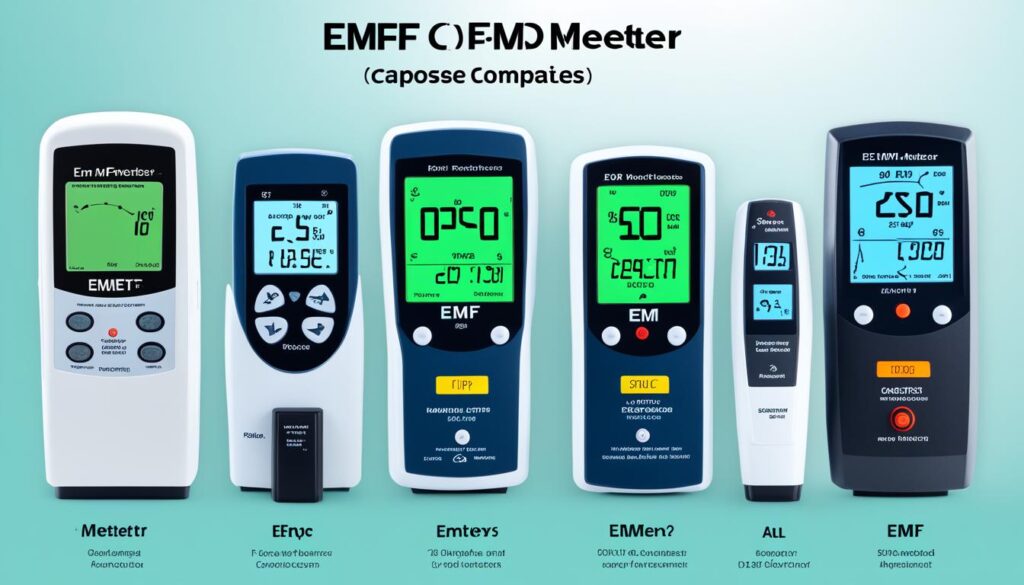
| EMF Meter Model | Key Features | Applications |
|---|---|---|
| Safe and Sound Pro II RF Meter | Advanced RF measurements Detailed data analysis | Professional use Assessing RF exposure |
| Safe and Sound Classic II | Affordable option Reliable RF measurements | General home use Monitoring wireless devices |
| TriField EMF Meter Model TF2 | Versatile meter Measures multiple types of EMFs | Electric fields Magnetic fields Radio frequencies |
| Safe and Sound Micro RF Detector | Highly sensitive Monitors RF exposure | Mobile device radiation Wireless network exposure |
Tips for Selecting the Right EMF Meter
When it comes to choosing the right EMF meter, it’s important to consider several factors that will ensure you find the perfect fit for your specific needs and requirements. By taking the time to evaluate these factors, you can make an informed decision and have peace of mind knowing that you have selected an EMF meter that will effectively measure and monitor electromagnetic fields. Here are some tips and factors to consider:
- Identify the primary application: Determine the main purpose for using the EMF meter. Are you looking to measure 5G radiation, or monitor the average power grid frequency? Identifying the primary application will help you narrow down your options and choose a meter that is specifically designed for that purpose.
- Consider accuracy and sensitivity: Accurate and sensitive readings are crucial for obtaining reliable data. Look for EMF meters that have high accuracy and sensitivity levels, as they will provide more precise measurements.
- Evaluate data display options: The way the data is displayed can greatly impact your user experience. Some meters offer simple color codes to indicate EMF levels, while others provide detailed numerical readings. Choose a meter with a data display option that suits your preferences and allows for easy interpretation of the results.
- Assess warranty and service support: It’s essential to choose an EMF meter from a reputable brand that offers warranty and service support. This ensures that you can rely on the manufacturer for any technical assistance or repairs that may be needed in the future.
- Read reviews and seek recommendations: Before making a final decision, take the time to read reviews from other users and seek recommendations from trusted sources. Hearing about firsthand experiences can provide valuable insights and help you make a more informed choice.
By following these tips and considering these factors, you can confidently select an EMF meter that meets your specific needs and provides accurate measurements of electromagnetic fields. Remember, choosing the right meter is crucial for protecting yourself and your family from potential health risks associated with EMFs.
Comparison of EMF Meter Models
| EMF Meter Model | Main Features | Primary Application | Price Range |
|---|---|---|---|
| Safe and Sound Pro II RF Meter | Detailed RF measurements | Advanced applications | $400 – $500 |
| Safe and Sound Classic II | Affordable and easy to use | General home use | $100 – $200 |
| TriField EMF Meter Model TF2 | Measure multiple types of EMFs | Versatile for various applications | $200 – $300 |
| Safe and Sound Micro RF Detector | Highly sensitive wristband detector | Monitoring RF exposure | $50 – $100 |
Conclusion
Choosing the right EMF meter is crucial for safeguarding yourself and your loved ones from the potential risks of EMF radiation. When making your selection, it’s important to carefully consider various factors, including the meter’s detection capabilities, frequency range, accuracy, sensitivity, and data display options. Take the time to compare different models and read reviews to find the one that best meets your specific needs and requirements.
Additionally, be sure to choose a reputable brand that offers warranty and service support. This ensures that you have long-term value and peace of mind with your purchase. With the right EMF meter, you’ll be equipped to measure and monitor EMF levels in your environment, enabling you to take proactive steps to minimize exposure and create a healthier home for you and your family.
By prioritizing the selection of an appropriate EMF meter, you are taking a proactive approach towards creating a safer living environment. Remember to assess and identify your specific needs, compare different models, and seek recommendations to make an informed decision. With the right EMF meter in your hands, you can effectively measure and monitor EMF levels, enabling you to take necessary precautions and reduce potential health risks. Invest in your well-being today and choose a reliable EMF meter that empowers you to protect yourself and your loved ones.
Source Links
- https://emf-protection.com/the-ultimate-guide-to-buying-an-emf-meter/
- https://www.admnucleartechnologies.com.au/blog/guide-buying-emf-meter
- https://schildemfprotect.com.au/blogs/news/choosing-the-right-emf-meter-guiding-the-path-to-a-healthier-home

Subscribe to Our Newsletter

